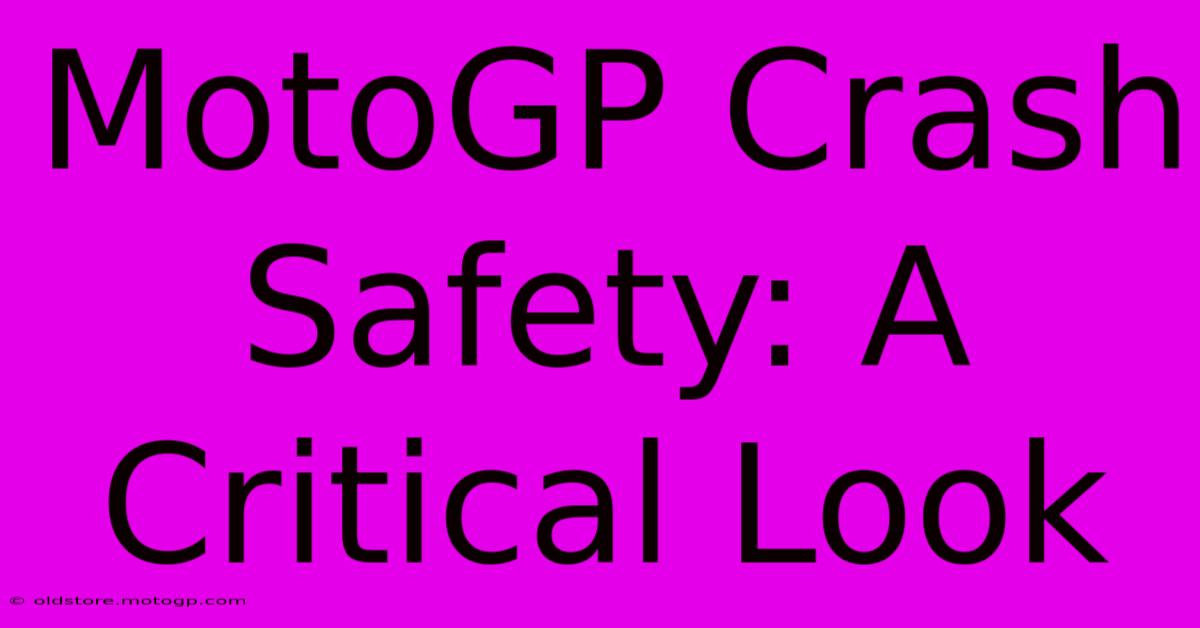MotoGP Crash Safety: A Critical Look

Table of Contents
MotoGP Crash Safety: A Critical Look
Motorcycle racing, particularly at the MotoGP level, is a breathtaking spectacle of skill and speed. However, the inherent risks are undeniable. While advancements in technology have significantly improved rider safety, the potential for serious injury remains a constant concern. This article delves into the critical aspects of MotoGP crash safety, examining both the progress made and the areas requiring further attention.
The Evolution of Safety Measures in MotoGP
Over the years, MotoGP has witnessed a dramatic evolution in safety protocols and equipment. This progress has demonstrably reduced the severity of injuries and fatalities. Key advancements include:
Improved Track Design:
- Run-off areas: Larger, more effectively designed run-off areas with improved gravel traps and air fences are crucial for slowing down bikes after crashes. These areas have become significantly wider and safer over the years.
- Track barriers: The implementation of safer barrier systems, including Tecpro barriers, has reduced the impact forces on motorcycles and riders during crashes. Constant refinement and updates to barrier technology are ongoing.
- Improved track surface: The quality and consistency of the track surface play a significant role in rider safety. Better drainage and surface composition help prevent loss of control and high-side crashes.
Advanced Rider Protection:
- Protective suits: Modern racing leathers are far superior to those of previous generations. They incorporate advanced materials designed to resist abrasion and impact, offering crucial protection in a crash. Features like strategically placed armor and integrated air bags significantly reduce injury risks.
- Helmets: Helmets represent the single most crucial piece of safety equipment. They undergo rigorous testing to ensure they meet the highest standards of impact protection. Constant innovation continues to improve helmet design and materials, increasing protection against rotational forces and impacts.
- Back protectors: Back protectors are now a standard feature, offering vital protection against spinal injuries, a common and potentially devastating consequence of crashes.
Medical Advancements:
- Trackside medical response: The rapid response of highly trained medical personnel at the track is paramount. Advanced medical equipment and immediate on-site care are critical in minimizing long-term damage following an accident.
- Air ambulances: The availability of air ambulances provides rapid transport to specialized medical facilities, ensuring riders receive the best possible treatment swiftly.
Ongoing Challenges and Future Directions
Despite the significant advancements, challenges remain:
- High-speed impacts: Even with improved safety measures, high-speed impacts remain a significant threat, causing severe injuries even with protective equipment. Research into new materials and technologies to absorb and dissipate energy more effectively is ongoing.
- Rotational forces: Rotational forces generated during crashes are a major cause of serious head and neck injuries. Further research and development in helmet technology and rider posture are critical.
- Data analysis and prevention: Collecting and analyzing data from crashes is vital for understanding accident causation and identifying areas for improvement in track design, safety protocols, and rider training.
The future of MotoGP safety relies on a multi-pronged approach:
- Continued investment in R&D: Ongoing investment in research and development is essential to improving protective equipment and track safety features.
- Data-driven improvements: Utilizing data analysis to identify patterns and trends in crashes can inform preventative measures.
- Enhanced rider training: Focus on advanced riding techniques and crash avoidance strategies can further reduce the risk of accidents.
Conclusion:
MotoGP's commitment to safety is evident in the significant advancements made in recent years. However, the pursuit of safety is an ongoing process. By constantly pushing the boundaries of technology, track design, and medical response, MotoGP can continue to minimize risks and ensure the sport remains exciting while prioritizing the well-being of its riders. The relentless drive towards improved safety is a testament to the sport's dedication to its athletes and the thrilling spectacle it provides.

Thank you for visiting our website wich cover about MotoGP Crash Safety: A Critical Look. We hope the information provided has been useful to you. Feel free to contact us if you have any questions or need further assistance. See you next time and dont miss to bookmark.
Featured Posts
-
Cota Parking Map Plan Your Arrival And Departure
Feb 19, 2025
-
Austin F1 Qualifying For Redemption
Feb 19, 2025
-
The Science Behind Moto Gp Race Track Design
Feb 19, 2025
-
Moto 3 Bikes Everything You Need To Know
Feb 19, 2025
-
Moto3 Bikes Your Key To The World Of Professional Racing
Feb 19, 2025
